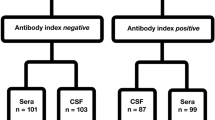Abstract
One hundred twenty-four patients—53 with neuroborreliosis, 48 with erythema migrans, and 23 with Lyme arthritis—were tested in a prospective study for the presence of the DNA of Borrelia burgdorferi sensu lato in plasma, cerebrospinal fluid (CSF), urine, and synovial fluid by nested polymerase chain reaction (PCR). Specific DNA was detected using five amplification systems simultaneously: three targeted chromosomal genes encoding 16S rDNA, flagellin, and p66; and two plasmid sequences of OspA and OspC. Patients were examined clinically and by PCR before and after treatment and again after 3 and 6 months. Before treatment, the specific DNA was detected in 78 patients (62.9 %). Forty-one neuroborreliosis patients were DNA-positive (77.4 %), with CSF positivity in 26 patients, urine in 25, and plasma in 16. Twenty-six erythema migrans patients were DNA-positive (54.2 %), with plasma positivity in 18 cases and urine in 14. Eleven Lyme arthritis cases (47.8 %) were DNA positive (six in urine, five in plasma, and four in synovial fluid). The frequency of PCR positives was comparable in CSF and urine, and it was lower by approximately 50 % in plasma. Specific DNA was also found in a significant number of patients in later testing periods: 48 patients after treatment, 29 patients after 3 months, and 6 patients after 6 months. The prolonged PCR positivity was not explainable by persistent infection according to the clinical manifestations of the disease. Possible explanations of the problem are discussed.

Similar content being viewed by others
Abbreviations
- AIBb :
-
Specific antibody index
- CSF:
-
Cerebrospinal fluid
- EIA:
-
Enzyme immunoassay
- EM:
-
Erythema migrans
- ISEM:
-
Immunosorbent electron microscopy
- LA:
-
Lyme arthritis
- LD:
-
Lyme disease
- NB:
-
Neuroborreliosis
- PCR:
-
Polymerase chain reaction
- WB:
-
Western blotting
References
Aberer E, Bergmann AR, Derler A, Schmidt B (2007) Course of Borrelia burgdorferi DNA shedding in urine after treatment. Acta Derm Venereol 87:39–42
Bathe CH, Schwartz RA (2011) Lyme disease: part II. Management and prevention. J Am Acad Dermatol 64:639–653
Bergmann AR, Schmidt BL, Derler AM, Aberer E (2002) Importance of sample preparation for molecular diagnosis of Lyme borreliosis from urine. J Clin Microbiol 40:4581–4584
Busson A, Reynders M, Van den Wijngaert S, Dahma H, Decolvenaer M, Vasseeuer L, Vandenberg O (2012) Evaluation of commercial screening tests and blot assays for the diagnosis of Lyme borreliosis. Diagn Microbiol Infect Dis 73:246–251
Cabello FC, Godfrey HP, Newman SA (2007) Hidden in plain sight: Borrelia burgdorferi and the extracellular matrix. Trends Microbiol 15:350–354
Dumler JS (2003) Molecular methods for ehrlichiosis and Lyme disease. Clin Lab Med 23:867–884
Embers ME, Barthold SW, Borda JT, Bowers L, Doyle L, Hodzic E, Jacobs MB, Hasenkampf NR, Martin DS, Narasimhan S, Phillippi-Falkenstein KM, Purcell JE, Ratterree MS, Philipp MT (2012) Persistence of Borrelia burgdorferi in rhesus macaques following antibiotic treatment of disseminated infection. PLoS One.:e29914. doi:10.1371/journal.pone.0029914
Feder HM Jr, Johnson BJ, O'Connell S, Shapiro ED, Steere AC, Wormser GP, Ad Hoc International Lyme Disease Group, Agger WA, Artsob H, Auwaerter P, Dumler JS, Bakken JS, Bockenstedt LK, Green J, Dattwyler RJ, Munoz J, Nadelman RB, Schwartz I, Draper T, McSweegan E, Halperin JJ, Klempner MS, Krause PJ, Mead P, Morshed M, Porwancher R, Radolf JD, Smith RP Jr, Sood S, Weinstein A, Wong SJ, Zemel L (2007) A critical appraisal of “chronic Lyme disease”. N Engl J Med 357:1422–1430
Hodzic E, Feng S, Holden K, Freet KJ, Barthold SW (2008) Persistence of Borrelia burgdorferi following antibiotic treatment in mice. Antimicrob Agents Chemother 52:1728–1736
Hulínská D, Votýpka J, Valešová M (1999) Borrelia garinii and Borrelia afzelii in patients with Lyme arthritis. Zentralbl Bakteriol 289:301–318
Iyer R, Mukherjee P, Wang K, Simons J, Wormser GP, Schwartz I (2012) Detection of Borrelia burgdorferi nucleic acids after antibiotic treatment does not confirm viability. J Clin Microbiol 51(3):857–62. doi:10.1128/JCM.02785-12
Kaiser R, Lücking CH (1993) Intrathecal synthesis of specific antibodies in neuroborreliosis, comparison of different ELISA techniques and calculation methods. J Neurol Sci 118:64–72
Lantos PM (2011) Chronic Lyme disease: the controversies and the science. Expert Rev Anti-Infect Ther 9:787–797
Lebech AM (2002) Polymerase chain reaction in diagnosis of Borrelia burgdorferi infection and studies on taxonomic classification. APMIS 110(Suppl 105):1–40
Mygland A, Ljostad U, Fingerle V, Rupprecht T, Schmutzhard E, Steiner I (2009) EFNS guidelines on the diagnosis and management of European Lyme neuroborreliosis. Eur J Neurol 17:8–16
Nocton JJ, Dressler F, Rutledge BJ, Rys PN, Persinf DH, Steere AC (1994) Detection of Borrelia burgdorferi DNAby polymerase chain reaction in synovial fluid in Lyme arthritis. N Engl J Med 330:229–234
Nolte O (2012) Nucleid acid amplification based diagnostic of lyme (neuro-)borreliosis—lost in the jungle of methods, targets, and assays? Open Neurol J 6(Suppl 1-M):129–139
Pícha D, Moravcová L, Ždárský E, Marešová V, Hulínský V (2005) PCR in Lyme neuroborreliosis: a prospective study. Acta Neurol Scand 112:287–292
Pícha D, Moravcová L, Holečková D, Ždárský E, Valešová M, Marešová V, Hercogová J, Vaňousová D (2008) Examination of specific DNA by PCR in patients with different forms of Lyme borreliosis. Int J Dermatol 47:1004–1010
Priem S, Burmester GR, Kamradt T, Wolbart K, Rittig MG, Krause A (1998) Detection of Borrelia burgdorferi by polymerase chain reaction in synovial membrane, but not in synovial fluid from patients with persisting Lyme arthritis after antibiotic therapy. Ann Rheum Dis 57:118–121
Rauter C, Mueller M, Diterich I, Zeller S, Hassler D, Meergans T, Hartung T (2005) Critical evaluation of urine-based PCR assay for diagnosis of Lyme borreliosis. Clin Diagn Lab Immunol 12:910–917
Stanek G, Wormser GP, Gray J, Strle F (2012) Lyme borreliosis. Lancet 379:461–473
Steere AC, Angelis SM (2006) Therapy for Lyme arthritis. Arthritis Rheum 54:3079–3086
Straubinger RK (2000) PCR-based quantification of Borrelia burgdorferi organisms in canine tissues over a 500-day postinfection period. J Clin Microbiol 38:2191–2199
Stricker RB (2007) Counterpoint: long-term antibiotic therapy improves persistent symptoms associated with Lyme disease. Clin Infect Dis 45:149–157
Strle F, Cheng Y, Cimperman J, Maraspin V, Lotric-Furlan S, Nelson JA, Picken MM, Ruzic-Sabljic E, Picken RN (1995) Persistence of Borrelia burgdorferi sensulato in resolved erythema migrans lesions. Clin Infect Dis 21:380–389
Varde S, Wormser GP, Nowakowski J, Nadelman RB, Bittker S, Cooper D, Schwartz I (1999) Lyme disease: disparity between culture and polymerase chain reaction detection of Borrelia burgdorferi after exposure to ceftriaxone in vitro. Conn Med 63:589–591
Wilske B, Fingerle V, Schulte-Spechtel U (2007) Microbiological and serological diagnosis of Lyme borreliosis. FEMS Immunol Med Microbiol 49:13–21
Wormser GP, Shapiro ED (2009) Implications of gender in chronic Lyme disease. J Womens Health 18:831–834
Wormser GP, Dattwyler RJ, Shapiro ED, Halperin JJ, Steere AC, Klempner MS, Krause PJ, Bakken JS, Strle F, Stanek G, Bockenstedt L, Fish D, Dumler JS, Nadelman RB (2006) The clinical assessment, treatment and prevention of Lyme disease, human granulocytic anaplasmosis and Babesiosis: clinical practice guidelines by the Infectious Diseases Society of America. IDSA Guidelines. Clin Infect Dis. 43: 1089–1134
Wormser GP, Nadelman RB, Schwartz I (2012) The amber theory of Lyme arthritis: initial description and clinical implication. Clin Rheumatol 31:989–994
Yrjänäinen H, Hytönen J, Hartiala P, Oksi J, Viljanen MK (2010) Persistence of borrelial DNA in the joints of Borrelia burgdorferi-infected mice after ceftriaxone treatment. APMIS 118:665–673
Acknowledgments
The study was supported by grants from the Ministry of Health of Czech Republic (IGA NR/8293 and NT/13467).
Ethical standards
This study was approved by the hospital ethical committee. All enrolled patients expressed their agreement by signing a patient's informed consent.
Conflict of interest
The authors confirm that they have no conflicts of interest.
Author information
Authors and Affiliations
Corresponding author
Rights and permissions
About this article
Cite this article
Pícha, D., Moravcová, L., Vaňousová, D. et al. DNA persistence after treatment of Lyme borreliosis. Folia Microbiol 59, 115–125 (2014). https://doi.org/10.1007/s12223-013-0272-4
Received:
Accepted:
Published:
Issue Date:
DOI: https://doi.org/10.1007/s12223-013-0272-4




